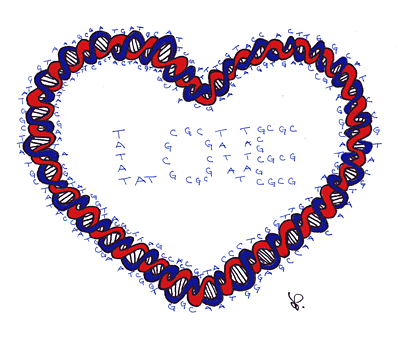|

I wait in
the glass-enclosed foyer at the Chand Palace restaurant for my
Indian lunch-to-go when I spot two young men eating together at
a table, deep in conversation. One is Hispanic, his dark hair in
a ponytail down his back. The other is white with blue eyes. His
short curly hair and eyebrows are red. It strikes me that my son
could look like the dark one.
In any other year of my life, I'd have assumed the opposite. But
not now, not after the stillbirth of my only biological child,
not after the infertility that followed, not as I made plans for
international adoption. I look at the men as I would at an enchanting,
foreign land on which I've just set foot.
Imagining people of other races as part of my family is changing
me. During an early spring shopping fling in bohemian New Hope,
Pennsylvania, my husband and I stopped at a sidewalk display and
browsed through pink and purple flip-flops.
“These would be great for Ada,” he
said, referring to my 11-year-old Indonesian foster daughter.
In her village everyone wears flip-flops and these were deluxe.
Another time, at an adoption agency
party, we watched as four tiny girls from China helped clean
up. They'd each taken a corner of a folding chair. One said, “One, two, three, lift!” The
four muscled the chair off the ground and moved it several feet
before the leader called for a rest. The girls then climbed into
an empty tube toy, which my husband dragged around. Inside four
delicate voices squealed with delight.
Hints of this destiny have always been with me. Maybe everyone's
life works like this: Our experiences seem random as we move through
them, and we only see the patterns when we look back.
In John Irving's “A Prayer for Owen Meany,” Owen is the only child
of a New Hampshire granite quarrier. He's small, even after he
grows up, and his voice never matures. His best friend is John
Wheelwright. As boys, the two constantly practice “The Shot,” a
basketball play in which John throws the ball to Owen, who catches
it and leaps into John's arms. John lifts Owen high enough to sink
a basket.
There comes a day, when, as adults, Owen and John find themselves
in a men's room in an Arizona airport with seven Vietnamese boys
on their way to new homes in America. A fanatic with a Chicom grenade
enters. Owen calms the children in Vietnamese. They lie on the
floor, cover their ears and close their eyes, trusting him because
he sounds like one of them.
“NOW I KNOW WHY MY VOICE NEVER CHANGED,” Owen says to John. “DO
YOU SEE WHY?”
The fanatic rips the fuse cord and throws the weapon to John,
who catches it as he would a basketball:
...I looked at Owen who was already moving toward me.
“READY?” he said. I passed
him the Chicom grenade and opened my arms to catch him. He
jumped so lightly into my hands; I lifted him up - as easily
as I had always lifted him.
After all: I had been practicing lifting up Owen Meany forever.
Owen tosses the grenade onto a window ledge and covers it with
his body. It kills him, but the children are saved.
We all get The Shot, but no one knows when it may appear or how
long we've been preparing for it.
In 1973 my mother, father, brother and I were in a rowboat on
a brown river outside Bangkok. Ours was one of several carrying
tours of Americans. It was morning and we were headed to a village
with homes on stilts above the water. The people washed, cooked
and relieved themselves in that water.
Before we'd left our house in New Jersey, my parents had given
me a new Instamatic camera and an orange camera bag. I was the
family correspondent, the one who photographed, saved samples of
foreign money and kept the travelogue. Naked brown children in
the distance jumped in glee and shouted things when they saw our
flotilla. They dove and swam until they reached us and clung to
the sides of our boats, hands outstretched. The guide said the
equivalent of an American quarter would make them happy.
One Thai boy looked straight at me. His skin glistened with dirty
water; his dark wet hair clung to his head. The sun burned the
scalp between my blonde pigtails. The boy would have made a terrific
picture, but I didn't take it. Yet I still can see his face. Sometimes
I think that day was the first time I looked my own child in the
eyes.
I remember the boy as I look at the two men at the table in the
Chand Palace and I wonder how life could have taken me this far.
I grew up white, Catholic and middle class with a father whose
vocabulary I had to reach up to and a mother who saw to it the
sheets on my bed were clean and wind-scented from drying on the
line. My friends were Italian- and Irish-American.
An Indian waiter scoops my lunch into aluminum tins palak
paneer (chunks of cheese in spinach) and other treats from
the buffet whose names I don't yet know. The man at the cashier
in the foyer explains it's Lord Krishna who sits in the garden
in the painting above the register. He adds that the deity Krishna
teaches, through stories, how to balance intellect and emotions.
The dark man at the table looks Central American. I notice because
my baby likely will come from Guatemala. I am learning Spanish
again so my baby will feel comfortable with my voice on the plane
trip home. Recently I delighted in a news story about the oldest
Mayan artifacts ever found being unearthed in Guatemala. I wondered
if my child, whoever he is, lives close to the site and if he is
descended from the Mayans.
Maybe this is the way the world really changes. The dream of my
family has expanded from my egg and my husband's sperm to span
race, culture, class, the globe.
Recently, I found myself comforted by
the scientific theory that all humans may have descended from one
woman the so-called mitochondrial Eve who lived in Africa some
150,000 years ago. I like the idea we're all one big family. Mitochondria,
a part of every human cell that produces the energy needed for
life, has its own DNA, different from the principal DNA that determines
such things as eye color. When a man and woman mate, their DNA
combine to create a unique set of genes, but mitochondrial DNA,
passed only from mother to daughter, doesn't change. Through it,
individuals alive now can trace their lineage to one of Eve's descendants,
who branched into groups and migrated all over the globe. According
to geneticists, their bodies and colorings changed as they adapted
to the vagaries of different climates and necessities of survival,
but they remained one familily.
When the waiter hands me my aromatic bag of exotic food, I realize
how familiar the fragrance of Indian herbs has become. As I leave,
the two men laugh at something one of them has said, and life feels
right. 
|
